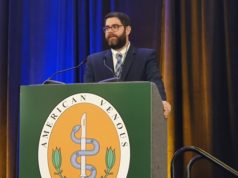
Reflux of the lateral subdermic plexus—varicose veins which appear on the outside of the thigh and calf—could be closely related to the symptoms of restless leg syndrome and night-time cramping, according to a review conducted on prospective symptom tracking and patient outcomes at The Vein Institute in Rochester, New York, USA. Patients suffering from conditions such as restless leg syndrome frequently present with symptoms of chronic venous insufficiency, but no specific pattern or association has been identified until now.
Speaking at the 2019 Vascular Interventional Advances conference (VIVA; 4–7 November, Las Vegas, USA), Swar Shah (Rochester General Hospital and The Vein Institute, New York, USA) further explained the paradigm of restless leg syndrome to those in attendance: “Many of these patients will present with more than the classic truncal symptoms, but the restless legs will typically present with a chronic inability to find comfortable positions when sleeping at night, and night-time cramping comes with this.”
As Shah delineated during his presentation, prospective symptom tracking on the standardised patient intake form began at The Vein Institute in January 2015, under the supervision of Raj Pyne (Rochester General Hospital and The Vein Institute, New York, USA). Pyne noticed that many of the patients with symptoms of these conditions demonstrated a similar distribution of varicosities, spider vein clusters, or both, with a common pattern along the lateral lower thigh, knee and calf emerging.
“This corresponds to the lateral subdermic plexus, which is a small grouping of tributary veins that drain into the Vein of Albanese and then to the deep venous system,” Shah said, highlighting the association. “Many patients who started to undergo treatment of these veins—mainly in association with other typical varicose veins or coincidentally for cosmetic spider veins—experienced a significant improvement in their restless leg syndrome and night-time cramping symptoms,” he revealed.
A proposed aetiology for restless legs was also presented by the speaker, who discussed a hypothesis for why these symptoms occur. The normal thigh component of the lateral subdermic plexus drains inferiorly towards the knee to the deep veins, while the calf component drains superiorly towards the knee. Without the aid of gravity—when patients are laying supine—Shah explained that there is impaired flow from the lateral subdermic plexus to the deep veins which, along with reflux, can lead to venous stasis.
“Our theory is that it is this venous stasis which causes the restless leg syndrome to develop, and we think that it may be related to iliotibial band irritation, although this theory is not borne out in the literature,” Shah commented. In order to explore this theory further, prospective symptom tracking and patient outcomes were evaluated; this focused on patient-reported symptoms of restless legs, patient-reported symptoms of night-time cramping and venous reflux with augmentation in the lateral subdermic plexus on venous ultrasound lasting more than 500 milliseconds.
“The spectral Doppler ultrasound findings would show a dilated lateral system (4mm with four seconds of reflux is pretty typical) and by comparison, we would often see patients with either large varicose veins or, in some cases, no large varicose veins in the more standard vessels we evaluate, such as the great saphenous vein,” said Shah, who added that “in more than one patient, the great saphenous vein was non-dilated and non-refluxing, yet patients still had symptoms of restless leg syndrome”.
As a result, patients who underwent treatment with ultrasound-guided foam sclerotherapy (USGFS) were also tracked, including clinical success (defined as technical success, short term symptom relief by 90 days, and long term symptoms relief at one year) and any major or minor complications. In total, 510 patients were identified between January 2015 and December 2017; 322 of these persons (63.1%) had an abnormal lateral system based on the investigators’ criteria, while the remaining 188 patients (36.9%) had either a normal lateral system, or it was not identified.
Focusing on the results, Shah said: “As we go to correlate the ultrasound findings with their symptoms, we start to see some patterns emerge. In patients with restless leg syndrome, 83% will have a positive ultrasound, and with patients suffering from night-time cramping symptoms, 89% will have a positive ultrasound. When you combine these results together, as restless leg syndrome and the cramping symptoms, a positive ultrasound will be present in 91% of patients with symptoms, while 98% of patients without will have a negative ultrasound.”
Technical success rate was 94%. For patients who underwent USGFS, 93% (224 patients out of 241) reported symptom resolution at 90-day follow-up, indicating clinical success. At one-year follow-up, this number was essentially unchanged at 92%, underlining that this can be “a very durable and likely permanent treatment option”.
Based on these findings, Shah concluded: “We view our study as a starting point, and we would like to see a standardised, multicentre evaluation take place in the future. If this does prove to be a cause of restless leg syndrome, as we think it might be, then it would open up a new avenue for potential treatment options for many patients. Not only would it be safe and effective, but it would also be cost-effective.”












